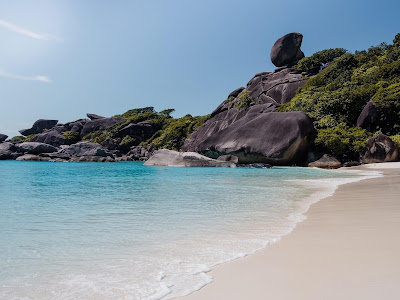Exploring the enchanting Similan Islands, Thailand's jewel of the Andaman sea.
Nestled in the turquoise waters of the Andaman Sea, off the coast of southern Thailand's Phang Nga province, lies a paradise known as the Similan Islands. Comprising eleven pristine islands, this archipelago is renowned for its breathtaking natural beauty, vibrant marine life, and captivating coral reefs.
As part of the Similan Islands National Park, this secluded haven offers visitors an unparalleled opportunity to immerse themselves in the wonders of the tropical marine ecosystem. In this article, we embark on a journey to explore the allure and charm of the Similan Islands, uncovering its rich biodiversity, cultural significance, and the efforts undertaken for its preservation.
The Beauty of the Similan Islands.
The Similan Islands boast some of the most stunning landscapes in Thailand. With their powder white sandy beaches, crystal clear waters, and lush greenery, each island presents a postcard perfect scene that is nothing short of mesmerizing. One of the most iconic spots is Donald Duck Bay on Koh Similan, named after a distinctive rock formation resembling the beloved Disney character. Here, visitors can bask in the sun, swim in the azure waters, or simply marvel at the natural splendor surrounding them.
Exploring Beneath the Surface: Marine Life and Coral Reefs.
Beyond its picturesque shores, the The Similan Islands boast some of the most stunning landscapes in Thailand teeming with diverse marine life. Snorkeling and diving enthusiasts flock to these waters to discover the kaleidoscope of colors that adorn the coral reefs and encounter an array of fascinating creatures. From graceful manta rays and playful dolphins to elusive whale sharks and colorful reef fish, the marine biodiversity here is truly awe inspiring.
The coral reefs of the Similan Islands are equally captivating, renowned for their pristine condition and remarkable variety. Coral gardens stretch as far as the eye can see, offering a kaleidoscopic display of shapes, sizes, and hues. These reefs serve as vital habitats for countless species of fish, crustaceans, and other marine organisms, contributing to the ecological richness of the region. However, they also face threats from climate change, overfishing, and destructive fishing practices, highlighting the importance of conservation efforts to safeguard their future.
Preservation and Conservation Efforts.
Recognizing the ecological significance of the Similan Islands, the Thai government established the Similan Islands National Park in 1982 to protect its fragile ecosystems and promote sustainable tourism. The park encompasses not only the islands themselves but also the surrounding waters, ensuring the preservation of marine habitats and species.
Park authorities have implemented various measures to manage visitor impact, including limiting the number of daily visitors, imposing strict waste management regulations, and establishing designated snorkeling and diving sites to prevent damage to sensitive coral reefs. Additionally, educational programs and awareness campaigns aim to promote responsible tourism practices and foster a greater understanding of the importance of marine conservation.
Challenges and Conservation Initiatives.
Despite these efforts, the Similan Islands face numerous challenges that threaten their ecological integrity. Climate change induced phenomena such as coral bleaching and ocean acidification pose significant risks to coral reefs, while illegal fishing activities and pollution further exacerbate the problem.
In response, conservation organizations, government agencies, and local communities have joined forces to implement initiatives aimed at mitigating these threats and preserving the biodiversity of the region.
One such initiative is the Coral Restoration Project, which seeks to rehabilitate damaged coral reefs through the propagation of coral fragments and the transplantation of healthy corals. By engaging local communities in reef restoration activities and promoting sustainable fishing practices, the project aims to enhance the resilience of coral ecosystems and foster a sense of stewardship among stakeholders.
In addition to conservation efforts, ecotourism initiatives play a crucial role in supporting the sustainable development of the Similan Islands. Responsible tour operators offer guided excursions that prioritize environmental protection and adhere to strict codes of conduct to minimize their ecological footprint. By promoting ecologically sensitive tourism practices, these initiatives contribute to the long term viability of the islands as a premier destination for nature lovers and adventure seekers alike.
Cultural Significance and Heritage.
Beyond its natural splendor, the Similan Islands hold cultural significance for the local Moken community, also known as sea gypsies, who have inhabited the region for centuries. The Moken people have a deep connection to the sea and its resources, relying on traditional fishing and marine harvesting techniques to sustain their way of life. Their unique cultural heritage adds another layer of richness to the tapestry of the islands, offering visitors a glimpse into a traditional way of life shaped by the rhythms of the ocean.
The Similan Islands stand as a testament to the enduring beauty and resilience of Thailand's marine ecosystems. With their pristine beaches, vibrant coral reefs, and rich biodiversity, these islands are a haven for nature enthusiasts and conservationists alike. As we continue to navigate the challenges posed by climate change and human activity, it is imperative that we work together to protect and preserve this precious natural heritage for future generations to enjoy.
By embracing sustainable tourism practices, supporting conservation initiatives, and fostering a deeper appreciation for the wonders of the marine world, we can ensure that the Similan Islands remain a jewel of the Andaman Sea for years to come.













